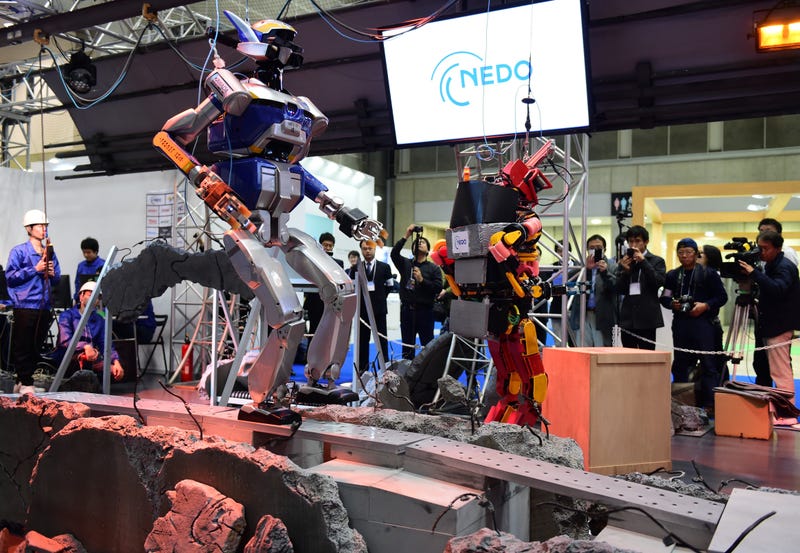
The four-day International Robot Exhibition just wrapped up in Japan over the weekend, and the wild machines introduced in Tokyo, one of the world’s biggest robot hubs, did not disappoint. The show attracted 450 companies and 5,000 non-robotic humans. Here’s a look at some of coolest from the show floor.
RC Origami Cranes


This remote-controlled origami crane weighs 31 grams (around .07 pounds) and was developed by Rohm Group, a Japanese electronics parts manufacturer. It’s called the Lazurite Fly, and we wrote about it when it debuted at Tokyo’s CEATEC emerging tech conference this fall. Its 3D-printed nylon body and carbon-tube frame make it extra light so it can soar weightlessly into the future.
Toyota’s Item-Fetching Helper Bot


Toyota has made no bones about wading deeper into the robot world, and the company debuted this latest little creation during the show last week. The Human Support Robot, or HSR for short, picks up after humans, fetches them stuff and ferries it to their bedside, and even opens curtains—all of these tasks are useful for bed-bound patients or the elderly.
Credit: AP Photo/Shizuo Kambayashi
Baby-Shaped, Long-Distance Communicators


This child-shaped, talking robotic head-and-torso looks ridiculously unnerving, but never fear, it’s just a specialized communication concept. Called “Telenoid,” it’s supposed to “transfer” people’s “presence”—meaning, it’s like a soft vaguely human-shaped telephone. A faraway user speaks into an app and their voice is projected from the robot. Telenoid is designed by Osaka University professor Hiroshi Ishiguro, one of the most skilled robot makers in the world.
Rescue Humanoids for Disaster Zones



In between Fukushima fallout and being one of the most quake and tsunami-prone nations on Earth, Japan pursues robotics that are decidedly disaster-focused. Take Kawada’s humanoid HRP-2, seen here, navigating mock debris and walking across precarious materials you might find in a disaster-struck area.
GIF credit: Reuters video/The Star Online YouTube

Here’s another humanoid bot with a disaster relief focus: The University of Tokyo’s Jaxon, which you see here performing the very human task of turning on a valve. Emergency response robots not only need to access places humans can’t—but when they get there, they also have to carry out tasks a human can do.
Hyper Realistic Androids of Dead Historical Figures

This wizened, Japanese-speaking Leonardo da Vinci bot was developed by the University of Osaka, Reuters reports. The goal here is to explore using androids based on historical figures to teach students about history.
GIF credit: Reuters video/The Star Online YouTube
Pepper

Here, we see a pack of Peppers “resting” before they take to the show floor. Pepper is the friendly, conversational humanoid that is able to read human facial expressions and emotions and change its behavior accordingly. A Pepper might, for example, tell you a joke when it notices that you’re sad. It’s a project by Japanese telecom giant SoftBank and French robotics company Aldebaran. Pepper will come to North America eventually
Powered Exoskeletons


Powered exoskeletons like these—the top is one designed by University of Tokyo, the bottom one by elder care company Asahi Sun Clean—use compressed air to help folks walk or lift heavy objects. This is a boon to disabled patients, or for senior citizens. Japan’s population is the fastest aging in the world, so these auxiliary skeletons are of particular interest for the nation.
Moving Mannequins


Introducing mannequins from the future. Designed by Japanese robotics company Muscle Corporation, these actually move and can strike different poses. (Sound familiar?) Japan is one of the first countries that’s been slowly rolling out robot staff in shops
Super Strong, Super Smart Industrial Lifters
Finally, check out this monster robot arm, seen here in a video filmed by YouTube channel Otoo TV. It’s an industrial robot from Fanuc Corp. that can lift this car without breaking an oil-sweat. The company is working on making industrial lifters that use deep learning to find and pick up heavy, randomly positioned objects with 90 percent accuracy, Bloomberg reports.
Photo credits, unless stated otherwise: Yoshikazu Tsuno/AFP/Getty Images
Top GIF credit: Otoo TV YouTube
Email the author at bryan@gizmodo.com, or follow him on Twitter.